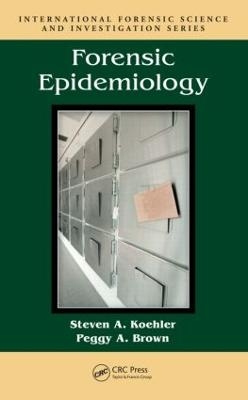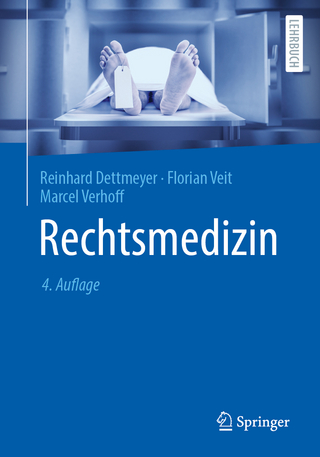
Forensic Epidemiology
Seiten
2009
Crc Press Inc (Verlag)
978-1-4200-6327-1 (ISBN)
Crc Press Inc (Verlag)
978-1-4200-6327-1 (ISBN)
After 9/11, the forensic epidemiology field emerged as a leading investigative tool. This book begins with a brief overview of epidemiological science and the history of forensic epidemiology before examining the multiple functions of death certificates and the signature role of forensic epidemiologist's in death investigations.
After 9/11, forensic epidemiology emerged as a leading investigative tool, partnering public health officers with law enforcement like never before. Based on the authors’ first-hand experience, Forensic Epidemiology brings to light the vast amounts of information collected by medical examiners that will be useful in advancing death investigation techniques among the forensic science, public health, and law enforcement fields.
This practical resource begins with a brief overview of epidemiological science and the history of forensic epidemiology before examining the multiple functions of death certificates and the signature role of forensic epidemiologists in death investigations. Incorporating numerous illustrations and real-world examples, the book:
Explains proven methods to collect, analyze, and interpret data for criminal investigations
Defines the terminology, methodology, procedures, and goals of all sectors involved for more effective collaboration
Examines deaths from natural, suicidal, accidental, homicidal, and undetermined causes
Describes the various decomposition states and methods used to establish positive identity
The increased frequency of criminal acts that involve deliberate biological and chemical agents underscores the need for collaboration between law enforcement investigators and public health professionals. As Forensic Epidemiology effectively demonstrates, when they work together, they can mount a powerful and successful response to threats to the American public.
Dr. Steven A. Koehler was interviewed in Volume 12 of Anil Aggrawal's Internet Journal of Forensic Medicine and Toxicology.
After 9/11, forensic epidemiology emerged as a leading investigative tool, partnering public health officers with law enforcement like never before. Based on the authors’ first-hand experience, Forensic Epidemiology brings to light the vast amounts of information collected by medical examiners that will be useful in advancing death investigation techniques among the forensic science, public health, and law enforcement fields.
This practical resource begins with a brief overview of epidemiological science and the history of forensic epidemiology before examining the multiple functions of death certificates and the signature role of forensic epidemiologists in death investigations. Incorporating numerous illustrations and real-world examples, the book:
Explains proven methods to collect, analyze, and interpret data for criminal investigations
Defines the terminology, methodology, procedures, and goals of all sectors involved for more effective collaboration
Examines deaths from natural, suicidal, accidental, homicidal, and undetermined causes
Describes the various decomposition states and methods used to establish positive identity
The increased frequency of criminal acts that involve deliberate biological and chemical agents underscores the need for collaboration between law enforcement investigators and public health professionals. As Forensic Epidemiology effectively demonstrates, when they work together, they can mount a powerful and successful response to threats to the American public.
Dr. Steven A. Koehler was interviewed in Volume 12 of Anil Aggrawal's Internet Journal of Forensic Medicine and Toxicology.
Steven A. Koehler, Peggy A. Brown
Epidemiology. Forensic Epidemiology. The Role of the Forensic Epidemiologist in the ME/C Office. The ME/C Office. Foundations of Forensic Epidemiology. The Death Certificate. Natural Deaths. Accidental Deaths. Suicide Deaths. Homicide Deaths. Undetermined Deaths. Special Cases. Forensic Papers/Studies. Expert Witness/Consulting.
| Erscheint lt. Verlag | 8.9.2009 |
|---|---|
| Reihe/Serie | International Forensic Science and Investigation |
| Zusatzinfo | 114 Tables, black and white; 19 Illustrations, black and white |
| Verlagsort | Bosa Roca |
| Sprache | englisch |
| Maße | 156 x 234 mm |
| Gewicht | 566 g |
| Themenwelt | Studium ► 2. Studienabschnitt (Klinik) ► Rechtsmedizin |
| Studium ► Querschnittsbereiche ► Epidemiologie / Med. Biometrie | |
| ISBN-10 | 1-4200-6327-8 / 1420063278 |
| ISBN-13 | 978-1-4200-6327-1 / 9781420063271 |
| Zustand | Neuware |
| Haben Sie eine Frage zum Produkt? |
Mehr entdecken
aus dem Bereich
aus dem Bereich
Befunderhebung, Rekonstruktion, Begutachtung
Buch | Hardcover (2024)
Springer (Verlag)
CHF 279,95
Ein praktisches Handbuch für Ärzte und Juristen
Buch | Hardcover (2020)
Urban & Fischer in Elsevier (Verlag)
CHF 329,95


